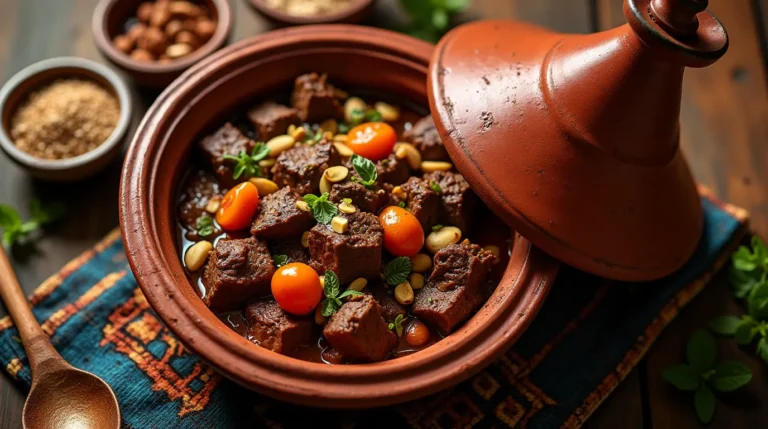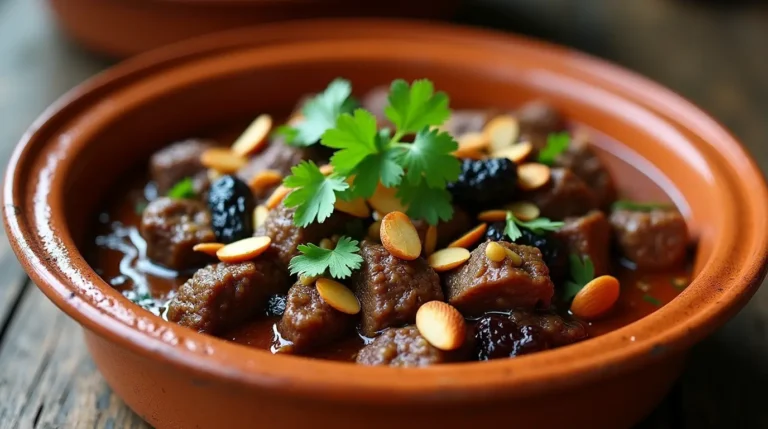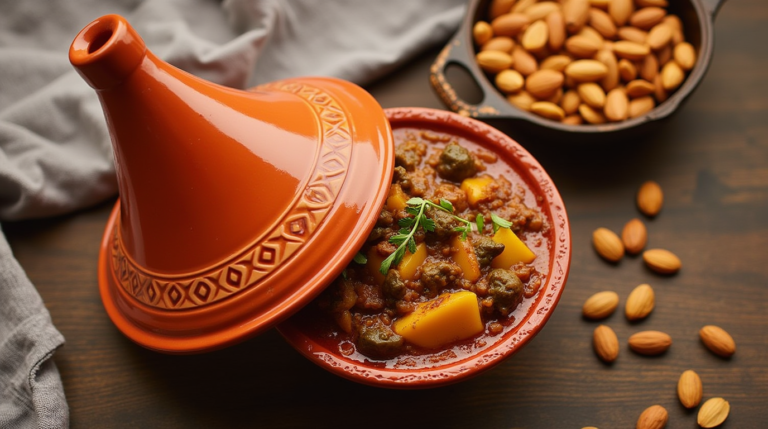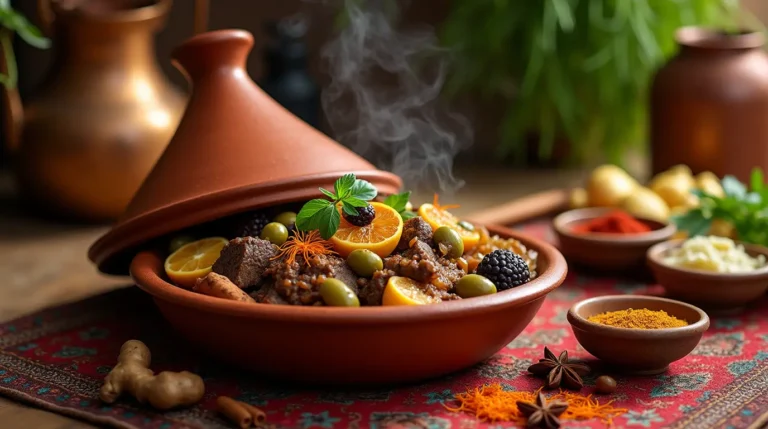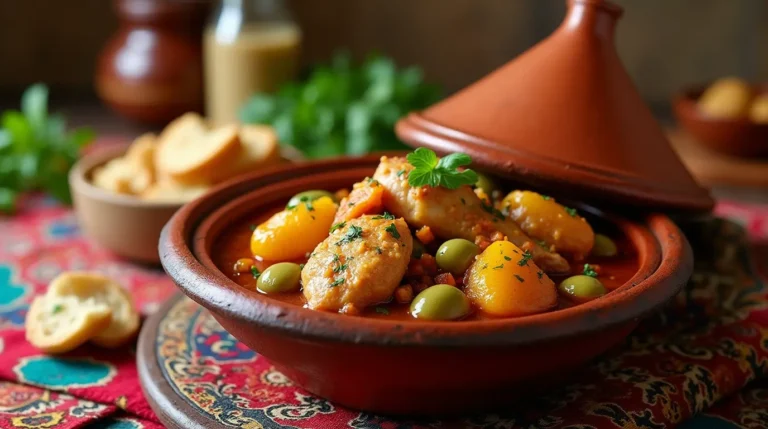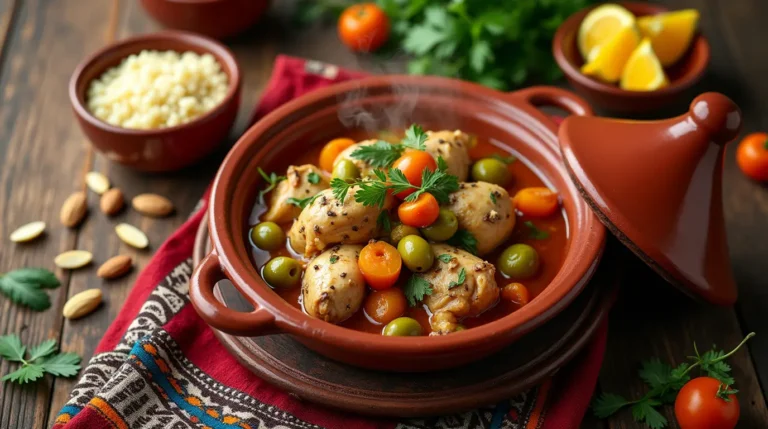Authentic Moroccan Beef Tagine Recipe
Hello, food lovers! Today I’m thrilled to share one of my absolute favorite dishes with you – an authentic Moroccan beef tagine that will transport your taste buds straight to the vibrant markets of Marrakech. If you’ve never experienced the magic of a properly prepared tagine, you’re in for a real treat. This slow-cooked stew combines tender beef with warm spices, sweet dried fruits, and savory vegetables to create a dish that’s truly unforgettable.
What makes tagine so special isn’t just the incredible flavor combination – it’s also the unique cooking vessel it’s named after. The conical-shaped tagine pot creates a self-basting cycle of steam that returns to the base, resulting in incredibly tender meat and vegetables infused with complex flavors. But don’t worry if you don’t own a tagine pot – I’ll show you how to achieve similar results with equipment you likely already have in your kitchen.
So gather your spices, prepare your ingredients, and let’s embark on a culinary journey to Morocco together!
Ingredients – Beef Tagine
For the spice blend:
- 2 teaspoons ground cumin
- 2 teaspoons ground coriander
- 1½ teaspoons ground ginger
- 1 teaspoon ground cinnamon
- 1 teaspoon paprika
- ½ teaspoon ground turmeric
- ½ teaspoon ground black pepper
- ¼ teaspoon cayenne pepper (adjust to taste)
For the tagine:
- 2 pounds beef chuck, cut into 1½-inch cubes
- 3 tablespoons olive oil
- 2 large onions, sliced
- 4 cloves garlic, minced
- 1 tablespoon fresh ginger, grated
- 1 cinnamon stick
- 2 bay leaves
- 1 can (14 oz) diced tomatoes
- 2 cups beef broth
- 1 tablespoon honey
- ½ cup dried apricots, chopped
- ½ cup dried prunes, chopped
- ⅓ cup green olives, pitted
- 2 tablespoons preserved lemon, chopped (or fresh lemon zest)
- ¼ cup fresh cilantro, chopped
- ¼ cup fresh parsley, chopped
- Salt to taste
- 2 tablespoons toasted almonds, sliced (for garnish)
Equipment:
- Tagine pot or Dutch oven
- Large mixing bowl
- Sharp knife and cutting board
- Measuring spoons and cups
- Wooden spoon
Preparation Time:
- Prep: 30 minutes
- Marinating: 1-2 hours (or overnight)
- Cooking: 2-3 hours
- Total: 3-4 hours (plus marinating time)
Step-by-Step Instructions – Beef Tagine
1. Prepare the Spice Blend and Marinate the Beef Tagine
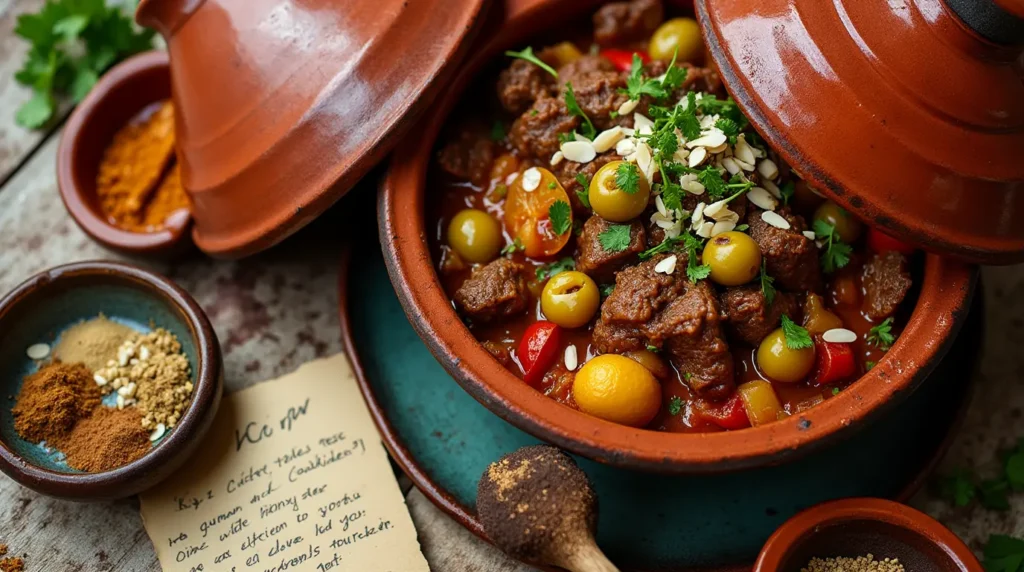
In a small bowl, combine all the spice blend ingredients: cumin, coriander, ginger, cinnamon, paprika, turmeric, black pepper, and cayenne. Mix thoroughly until well combined.
Place the beef cubes in a large bowl and sprinkle with two-thirds of the spice blend and a generous pinch of salt. Using your hands (wear gloves if preferred), massage the spices into the meat until each piece is well coated. Cover the bowl with plastic wrap and refrigerate for at least 1-2 hours, though overnight is even better if you have the time.
The marinating process is crucial as it allows the spices to penetrate the meat, resulting in a more flavorful tagine. This step alone will fill your kitchen with the most incredible aroma – a preview of the deliciousness to come!
2. Brown the Meat – Beef Tagine
When you’re ready to cook, heat 2 tablespoons of olive oil in your tagine pot or Dutch oven over medium-high heat. Working in batches to avoid overcrowding (which would steam rather than brown the meat), sear the beef cubes on all sides until they develop a rich, caramelized crust – about 3-4 minutes per batch.
Don’t rush this step! Proper browning creates the Maillard reaction, which develops deep, complex flavors that form the foundation of your tagine. As each batch finishes, transfer the seared meat to a plate and continue until all pieces are browned.
A helpful tip: Pat your meat dry with paper towels before adding it to the hot oil. Excess moisture will prevent proper browning and cause splattering.
3. Sauté the Aromatics – Beef Tagine
Reduce the heat to medium and add the remaining tablespoon of olive oil to the same pot. Add the sliced onions and sauté for about 5 minutes until they begin to soften and turn translucent.
Add the minced garlic and grated fresh ginger, then continue cooking for another 2 minutes until fragrant. The aroma at this point will be absolutely heavenly!
Sprinkle in the remaining spice blend and stir continuously for about 30 seconds to toast the spices and release their essential oils. This brief toasting intensifies their flavors significantly.
4. Combine Ingredients and Begin Slow Cooking – Beef Tagine
Return the browned meat to the pot, including any juices that have accumulated on the plate – that’s pure flavor you don’t want to waste!
Add the cinnamon stick, bay leaves, diced tomatoes (with their juice), and beef broth. Stir in the honey, which will add a subtle sweetness that balances the savory elements.
Bring the mixture to a gentle simmer, then reduce the heat to low. If using a traditional tagine pot, place the conical lid on top. If using a Dutch oven, cover with a tight-fitting lid.
Allow the tagine to simmer very gently for about 2 hours, or until the meat is fork-tender. Resist the urge to lift the lid frequently, as this will release the steam that’s crucial for tenderizing the meat.
5. Add the Fruits and Preserved Lemon – Beef Tagine
After about 2 hours of slow cooking, it’s time to add the dried fruits, which will plump up and absorb the sauce’s flavors while imparting their own sweetness.
Add the chopped apricots, prunes, green olives, and preserved lemon (or lemon zest if you don’t have preserved lemon). Gently stir these ingredients into the tagine, being careful not to break apart the now-tender beef.
Cover again and continue cooking for another 30 minutes. This final cooking period allows the fruits to soften and their flavors to meld with the sauce, creating that characteristic sweet-savory balance that Moroccan cuisine is famous for.
6. Final Seasoning and Garnishing – Beef Tagine
Once the cooking is complete, taste the sauce and adjust the seasoning if necessary. You may want to add more salt or a drizzle of honey depending on your preference.
Remove the cinnamon stick and bay leaves, then gently stir in most of the chopped cilantro and parsley, reserving some for garnish.
Sprinkle the top with the remaining fresh herbs and the toasted sliced almonds, which add a wonderful textural contrast to the tender stew.
Allow the tagine to rest, uncovered, for about 10 minutes before serving. This brief resting period allows the flavors to settle and intensify.
7. Serving Suggestions – Beef Tagine

Traditional Moroccan tagine is typically served family-style, directly from the cooking vessel if you’re using an authentic tagine pot. The dramatic removal of the conical lid at the table releases an enticing cloud of aromatic steam – a true feast for the senses!
Serve your beef tagine over fluffy couscous, which is perfect for absorbing the rich sauce. Alternatively, a crusty bread like Moroccan khobz or even a simple baguette works wonderfully for sopping up every last bit of the delicious sauce.
For an authentic Moroccan dining experience, consider these additional accompaniments:
- A small bowl of harissa (North African chili paste) for those who enjoy extra heat
- A side of plain yogurt to balance the richness of the tagine
- A simple salad of cucumber, tomato, and red onion dressed with lemon juice and olive oil
Tips for Success – Beef Tagine
Meat selection: While beef chuck is traditional and works perfectly, you could also use lamb shoulder for an equally authentic variation. The key is selecting a cut with some marbling that benefits from long, slow cooking.
Tagine pot vs. Dutch oven: If using a traditional clay tagine pot, you’ll need to use a diffuser if cooking on an electric stovetop. For first-time users of clay tagines, remember to season it properly before the first use (soak in water and rub with olive oil). A heavy Dutch oven is a perfectly acceptable alternative and easier to manage for beginners.
Balancing flavors: The interplay of sweet, savory, and aromatic elements is crucial in Moroccan cuisine. Feel free to adjust the honey, dried fruits, and spices to suit your taste preference.
Make-ahead option: Tagine actually improves in flavor when made a day ahead and reheated, making it perfect for entertaining or meal prep. Simply reheat gently on the stovetop, adding a splash of broth if needed to thin the sauce.
Cultural Context
Tagine has been a cornerstone of Moroccan cuisine for centuries, originating with the Berber people of North Africa. The dish represents the ingenuity of desert cooking, where the unique pot design conserves precious water and fuel while transforming tough cuts of meat into tender delicacies.
Traditionally, the tagine would be prepared in the morning and left to cook slowly over hot coals throughout the day, often in communal outdoor ovens. Families would drop off their prepared tagines and return later to collect their finished meals – an early form of slow cooking!
The combination of sweet and savory flavors reflects Morocco’s position at the crossroads of trade routes, incorporating spices from the Middle East, dried fruits from the Mediterranean, and cooking techniques from both Arabic and Berber traditions.
Conclusion
Creating an authentic Moroccan Beef Tagine at home is more than just preparing a meal – it’s embracing a centuries-old tradition of communal cooking and eating. There’s something deeply satisfying about the slow transformation of simple ingredients into a complex, aromatic dish that nourishes both body and soul.
The layering of flavors and textures – tender meat, sweet fruits, savory sauce, and crunchy nuts – creates a truly memorable dining experience that will have your family or guests asking for seconds and, most certainly, your recipe!
So the next time you’re looking to try something beyond your usual dinner rotation or wanting to impress guests with an exotic yet approachable dish, remember this tagine recipe. It’s proof that with some patience and quality ingredients, you can bring the magic of Moroccan cuisine right to your own table.
Have you tried making tagine before? I’d love to hear about your experiences or any variations you’ve enjoyed in the comments below!


